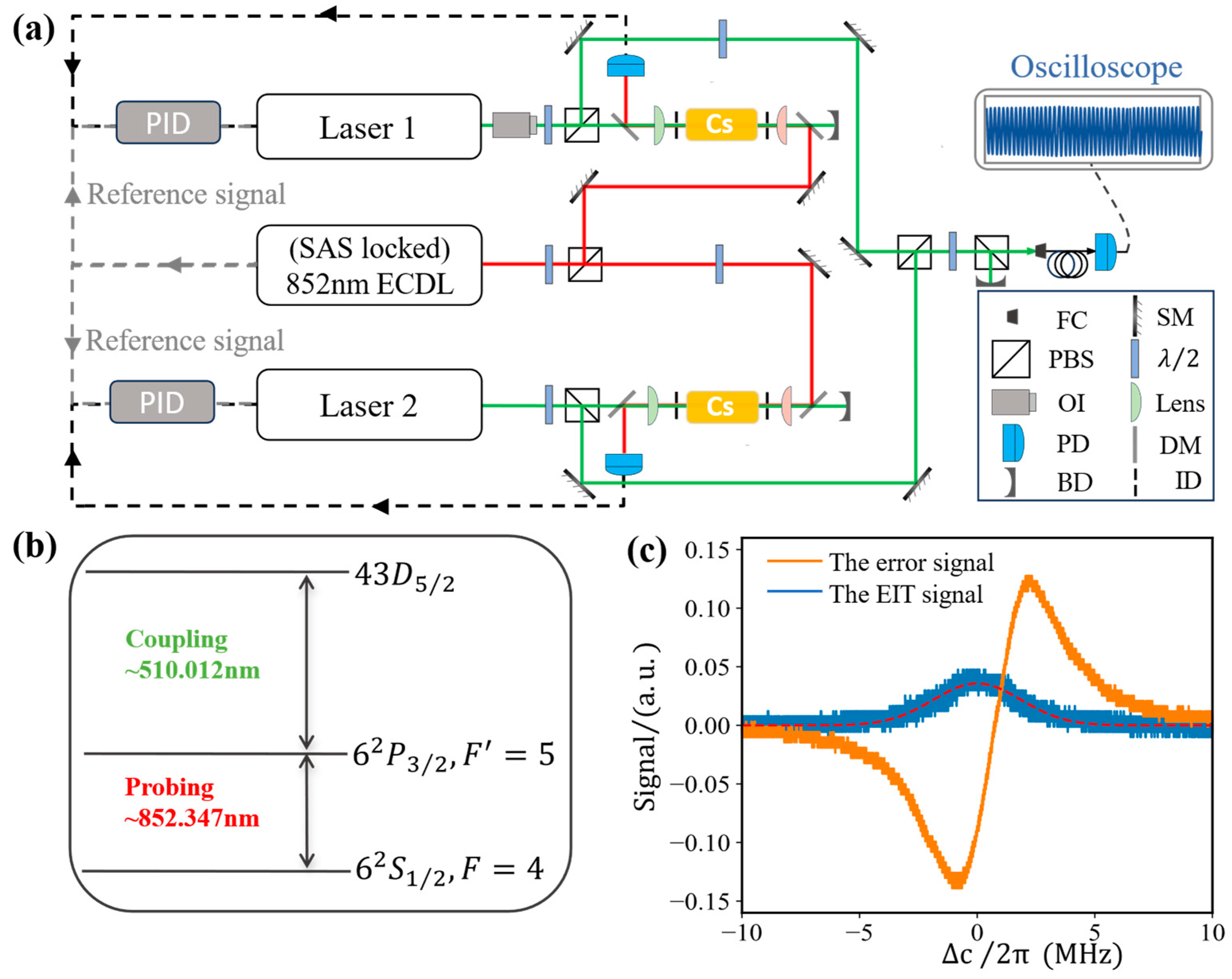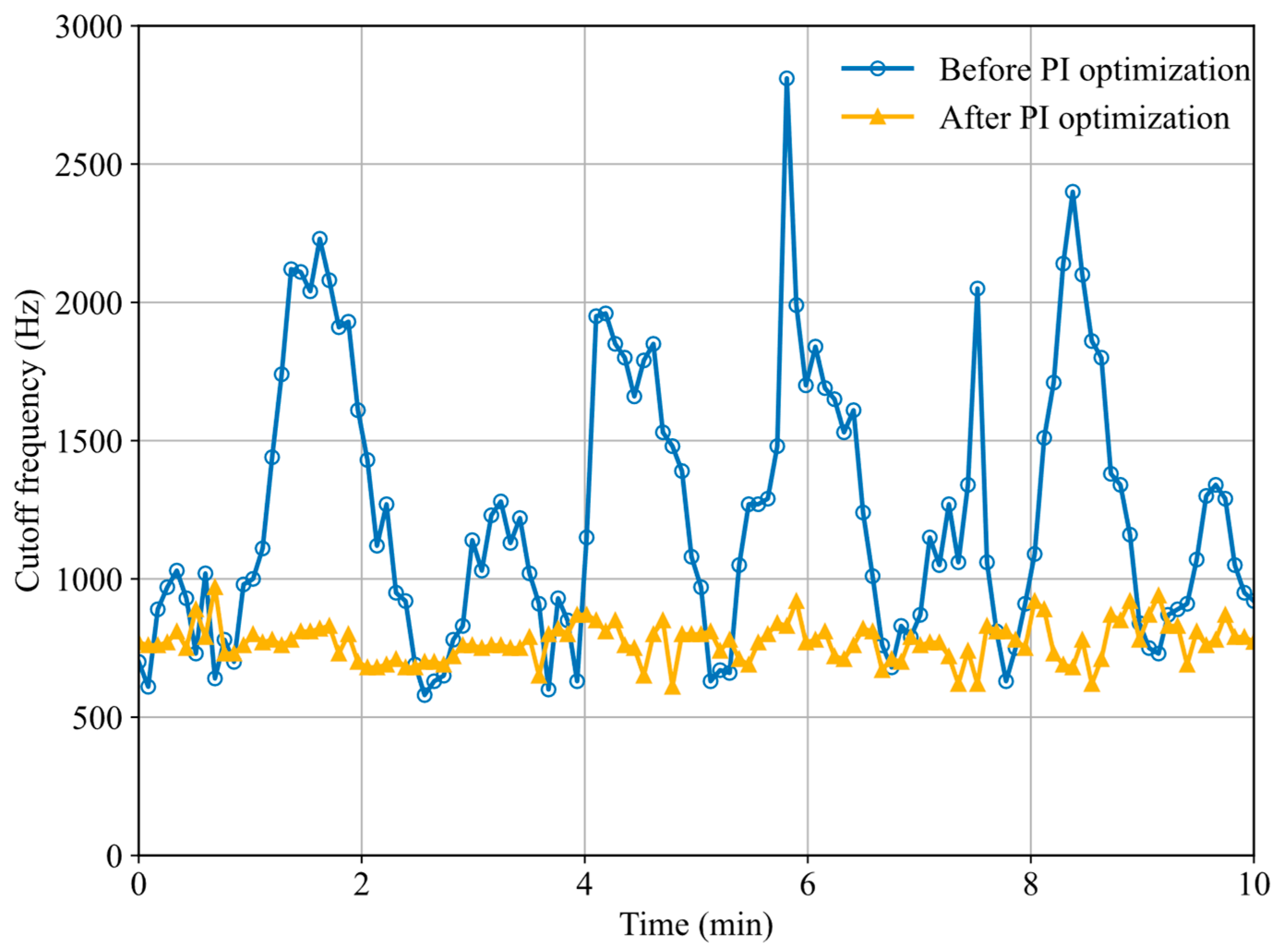Stability Assessment of Rydberg Electromagnetically Induced Transparency Locking via Optical Heterodyne Spectroscopy
Abstract
1. Introduction
2. Experimental Setup
3. Results
3.1. Simultaneous Locking of Two Coupling Lasers and Analysis of Beat Signal
3.2. Optimizing Frequency Locking Parameters Through Beat Signal
3.3. Characterization of Beat Frequency Spectra in Partially Locked Dual-Laser Systems
4. Conclusions
Author Contributions
Funding
Institutional Review Board Statement
Informed Consent Statement
Data Availability Statement
Acknowledgments
Conflicts of Interest
References
- Prodan, J.; Migdall, A.; Phillips, W.D.; So, I.; Metcalf, H.; Dalibard, J. Stopping Atoms with Laser Light. Phys. Rev. Lett. 1985, 54, 992–995. [Google Scholar] [CrossRef] [PubMed]
- Chow, M.N.H.; Little, B.J.; Jau, Y.-Y. High-Fidelity, Low-Loss State Detection of Alkali-Metal Atoms in Optical Tweezer Traps. Phys. Rev. A 2022, 108, 032407. [Google Scholar] [CrossRef]
- Bouillon, A.; Marin-Bujedo, E.; Génévriez, M. Direct Laser Cooling of Rydberg Atoms with an Isolated-Core Transition. Phys. Rev. Lett. 2024, 132, 193402. [Google Scholar] [CrossRef]
- Wildi, T.; Ulanov, A.E.; Voumard, T.; Ruhnke, B.; Herr, T. Phase-Stabilised Self-Injection-Locked Microcomb. Nat. Commun. 2024, 15, 7030. [Google Scholar] [CrossRef]
- Takamoto, M.; Hong, F.-L.; Higashi, R.; Katori, H. An Optical Lattice Clock. Nature 2005, 435, 321–324. [Google Scholar] [CrossRef] [PubMed]
- Ludlow, A.D.; Boyd, M.M.; Ye, J.; Peik, E.; Schmidt, P.O. Optical Atomic Clocks. Rev. Mod. Phys. 2015, 87, 637–701. [Google Scholar] [CrossRef]
- Steane, A. Quantum Computing. Rep. Prog. Phys. 1998, 61, 117. [Google Scholar] [CrossRef]
- Shih, C.-Y.; Motlakunta, S.; Kotibhaskar, N.; Sajjan, M.; Hablützel, R.; Islam, R. Reprogrammable and High-Precision Holographic Optical Addressing of Trapped Ions for Scalable Quantum Control. npj Quantum Inf. 2021, 7, 57. [Google Scholar] [CrossRef]
- Farooq, A.; Alquaity, A.B.S.; Raza, M.; Nasir, E.F.; Yao, S.; Ren, W. Laser Sensors for Energy Systems and Process Industries: Perspectives and directions. Prog. Energy Combust. Sci. 2022, 91, 100997. [Google Scholar] [CrossRef]
- Guo, Y.; Shen, Y.; Tong, X.; Wu, H. Simultaneous Measurement of Vibration and Temperature Based on FBG and DBR Fiber Laser Beat Frequency Digital Sensing System. Opt. Fiber Technol. 2023, 75, 103155. [Google Scholar] [CrossRef]
- Black, E.D. An Introduction to Pound–Drever–Hall Laser Frequency Stabilization. Am. J. Phys. 2001, 69, 79–87. [Google Scholar] [CrossRef]
- Chao, Y.-X.; Hua, Z.-X.; Liang, X.-H.; Yue, Z.-P.; You, L.; Khoon Tey, M. Pound–Drever–Hall Feedforward: Laser Phase Noise Suppression beyond Feedback. Optica 2024, 11, 945. [Google Scholar] [CrossRef]
- Bai, W.-L.; Peng, W.-C.; Zhang, Q.-Y.; Wang, C.; Ao, Z.-Y.; Tong, X. Long Term Frequency Stabilization and Frequency Drift Suppression of the 313 Nm Laser. Chin. J. Phys. 2024, 89, 1500–1507. [Google Scholar] [CrossRef]
- Preston, D.W. Doppler-Free Saturated Absorption: Laser Spectroscopy. Am. J. Phys. 1996, 64, 1432–1436. [Google Scholar] [CrossRef]
- Utreja, S. Frequency Stabilization of Multiple Lasers to a Reference Atomic Transition of Rb. Sci. Rep. 2022, 12, 20624. [Google Scholar] [CrossRef] [PubMed]
- Preuschoff, T.; Schlosser, M.; Birkl, G. Optimization Strategies for Modulation Transfer Spectroscopy Applied to Laser Stabilization. Opt. Express 2018, 26, 24010–24019. [Google Scholar] [CrossRef]
- Lee, S. Compact Modulation Transfer Spectroscopy Module for Highly Stable Laser Frequency. Opt. Lasers Eng. 2021, 146, 106698. [Google Scholar] [CrossRef]
- Lee, S.; Moon, G.; Park, S.E.; Hong, H.-G.; Seo, S.; Kwon, T.Y.; Lee, S.-B.; Lee, J.H. Laser Frequency Stabilization in the 10−14 Range via Optimized Modulation Transfer Spectroscopy on the 87Rb D2 Line. Opt. Lett. 2023, 48, 1020–1023. [Google Scholar] [CrossRef]
- Mohapatra, A.K.; Jackson, T.R.; Adams, C.S. Coherent Optical Detection of Highly Excited Rydberg States Using Electromagnetically Induced Transparency. Phys. Rev. Lett. 2007, 98, 113003. [Google Scholar] [CrossRef]
- Jiao, Y.; Li, J.; Wang, L.; Zhang, H.; Zhang, L.; Zhao, J.; Jia, S. Laser Frequency Locking Based on Rydberg Electromagnetically Induced Transparency. Chin. Phys. B 2016, 25, 053201. [Google Scholar] [CrossRef]
- Yang, K.; Mao, R.; An, Q.; Sun, Z.; Fu, Y. Laser Frequency Locking Method for Rydberg Atomic Sensing. Chin. Opt. Lett. 2023, 21, 021407. [Google Scholar] [CrossRef]
- Park, C.Y.; Yoon, T.H. Efficient Magneto-Optical Trapping of Yb Atoms with a Violet Laser Diode. Phys. Rev. A 2003, 68, 055401. [Google Scholar] [CrossRef]
- Elgin, J.D.; Heavner, T.P.; Kitching, J.; Donley, E.A.; Denney, J.; Salim, E.A. A Cold-Atom Beam Clock Based on Coherent Population Trapping. Appl. Phys. Lett. 2024, 115, 033503. [Google Scholar] [CrossRef] [PubMed]
- Legero, T.; Matei, D.G.; Häfner, S.; Grebing, C.; Weyrich, R.; Riehle, F.; Sterr, U.; Zhang, W.; Robinson, J.; Sonderhouse, L.; et al. 1.5 Μm Lasers with Sub 10 mHz Linewidth. Phys. Rev. Lett. 2017, 118, 263202. [Google Scholar]
- Bai, Z.; Zhao, Z.; Qi, Y.; Ding, J.; Li, S.; Yan, X.; Wang, Y.; Lu, Z. Narrow-Linewidth Laser Linewidth Measurement Technology. Front. Phys. 2021, 9, 768165. [Google Scholar] [CrossRef]
- Hu, S.; Lv, P.; Guan, C.; Li, S.; Qin, H.; Li, X.; Chen, X.; Zhan, L.; Wang, W.; Xiao, Y.; et al. Study on Linewidth and Phase Noise Characteristics of a Narrow Linewidth External Cavity Diode Laser. Sensors 2024, 24, 1103. [Google Scholar] [CrossRef]
- Wu, Y.; Qin, F.; Ding, Z.; Xu, R.; Li, D. Research on the Frequency Stabilization System of an External Cavity Diode Laser Based on Rubidium Atomic Modulation Transfer Spectroscopy Technology. Photonics 2024, 11, 298. [Google Scholar] [CrossRef]
- Uehara, T.; Tsuji, K.; Hagiwara, K.; Onodera, N. Optical Beat-Note Frequency Stabilization between Two Lasers Using a Radio Frequency Interferometer in the Gigahertz Frequency Band. Opt. Eng. 2014, 53, 124109. [Google Scholar] [CrossRef]
- Li, V.; Diorico, F.; Hosten, O. Laser Frequency-Offset Locking at 10-Hz-Level Instability Using Hybrid Electronic Filters. Phys. Rev. Appl. 2022, 17, 054031. [Google Scholar] [CrossRef]
- Idjadi, M.H.; Kim, K.; Fontaine, N.K. Modulation-Free Laser Stabilization Technique Using Integrated Cavity-Coupled Mach-Zehnder Interferometer. Nat. Commun. 2024, 15, 1922. [Google Scholar] [CrossRef]
- Shen, Z. Increase in the Signal-to-Noise Ratio of the Beat Note between a Frequency Comb and a Continuous-Wave Laser. Phys. Rev. Appl. 2024, 21, 034066. [Google Scholar]
- Schimpf, D.N.; Olgun, H.T.; Kalaydzhyan, A.; Hua, Y.; Kärtner, F.X. Frequency-Comb-Based Laser System Producing Stable Optical Beat Pulses with Picosecond Durations Suitable for High- Precision Multi-Cycle Terahertz-Wave Generation and Rapid Detection. Opt. Express 2019, 27, 11037–11056. [Google Scholar] [CrossRef] [PubMed]
- Siddharth, A.; Attanasio, A.; Bianconi, S.; Lihachev, G.; Zhang, J.; Qiu, Z.; Bancora, A.; Kenning, S.; Wang, R.; Voloshin, A.S.; et al. Piezoelectrically tunable, narrow linewidth photonic integrated extended-DBR lasers. Optica 2024, 11, 1062–1069. [Google Scholar] [CrossRef]
- Hill, J.C.; Holland, W.K.; Kunz, P.D.; Cox, K.C.; Penttinen, J.-P.; Kantola, E.; Meyer, D.H. Intra-Cavity Frequency-Doubled VECSEL System for Narrow Linewidth Rydberg EIT Spectroscopy. Opt. Express 2022, 30, 41408. [Google Scholar] [CrossRef]
- Ludvigsen, H.; Bodtker, E. New method for self-homodyne laser linewidth measurements with a short delay fiber. Opt. Commun. 1994, 110, 595–598. [Google Scholar] [CrossRef]
- Ali, A.H.; Abdul-Wahid, N. Analysis of Self-Homodyne and Delayed Self-Heterodyne Detections for Tunable Laser Source Linewidth Measurements. IOSR J. Eng. 2012, 2, 1–6. [Google Scholar]
- Zhou, T.; Qi, X.; Wang, Q.; Xiong, W.; Duan, J.; Zhou, X.; Chen, X. Frequency-stabilized diode laser at 780 nm with a continuously locked time over 100 h. Chin. Opt. Lett. 2010, 8, 496. [Google Scholar] [CrossRef]
- Jing, M.; Hu, Y.; Ma, J.; Zhang, H.; Zhang, L.; Xiao, L.; Jia, S. Atomic superheterodyne receiver based on microwave-dressed Rydberg spectroscopy. Nat. Phys. 2020, 16, 911–915. [Google Scholar] [CrossRef]
- Sedlacek, J.; Schwettmann, A.; Kübler, H.; Löw, R.; Pfau, T.; Shaffer, J.P. Microwave electrometry with Rydberg atoms in a vapour cell using bright atomic resonances. Nat. Phys. 2012, 8, 819–824. [Google Scholar] [CrossRef]
- Rathod, V.T. A Review of Electric Impedance Matching Techniques for Piezoelectric Sensors, Actuators and Transducers. Electronics 2019, 8, 169. [Google Scholar] [CrossRef]






Disclaimer/Publisher’s Note: The statements, opinions and data contained in all publications are solely those of the individual author(s) and contributor(s) and not of MDPI and/or the editor(s). MDPI and/or the editor(s) disclaim responsibility for any injury to people or property resulting from any ideas, methods, instructions or products referred to in the content. |
© 2025 by the authors. Licensee MDPI, Basel, Switzerland. This article is an open access article distributed under the terms and conditions of the Creative Commons Attribution (CC BY) license (https://creativecommons.org/licenses/by/4.0/).
Share and Cite
Yin, Q.; Liang, Y.; Lin, H.; Ji, N.; Vogt, T. Stability Assessment of Rydberg Electromagnetically Induced Transparency Locking via Optical Heterodyne Spectroscopy. Photonics 2025, 12, 374. https://doi.org/10.3390/photonics12040374
Yin Q, Liang Y, Lin H, Ji N, Vogt T. Stability Assessment of Rydberg Electromagnetically Induced Transparency Locking via Optical Heterodyne Spectroscopy. Photonics. 2025; 12(4):374. https://doi.org/10.3390/photonics12040374
Chicago/Turabian StyleYin, Qiuyu, Yanzhao Liang, Haitao Lin, Ning Ji, and Thibault Vogt. 2025. "Stability Assessment of Rydberg Electromagnetically Induced Transparency Locking via Optical Heterodyne Spectroscopy" Photonics 12, no. 4: 374. https://doi.org/10.3390/photonics12040374
APA StyleYin, Q., Liang, Y., Lin, H., Ji, N., & Vogt, T. (2025). Stability Assessment of Rydberg Electromagnetically Induced Transparency Locking via Optical Heterodyne Spectroscopy. Photonics, 12(4), 374. https://doi.org/10.3390/photonics12040374




